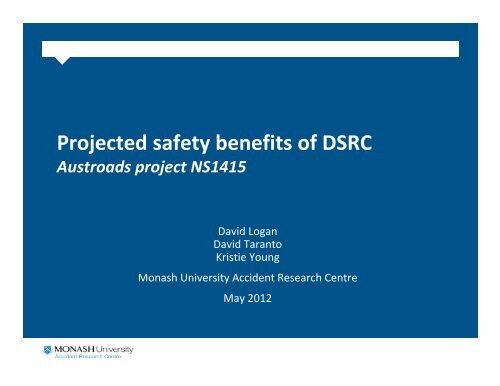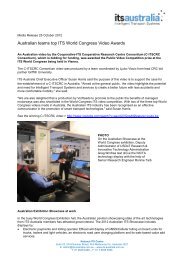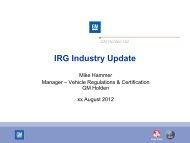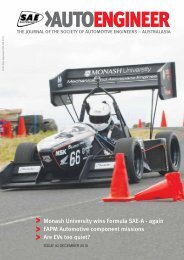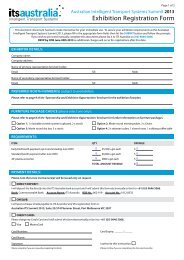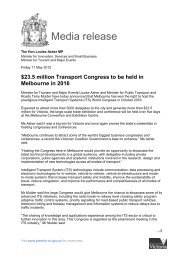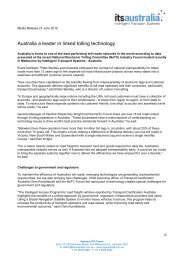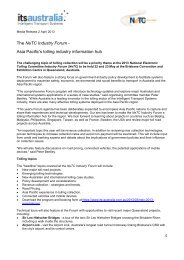Projected safety benefits of DSRC Presentation - ITS Australia
Projected safety benefits of DSRC Presentation - ITS Australia
Projected safety benefits of DSRC Presentation - ITS Australia
You also want an ePaper? Increase the reach of your titles
YUMPU automatically turns print PDFs into web optimized ePapers that Google loves.
<strong>Projected</strong> <strong>safety</strong> <strong>benefits</strong> <strong>of</strong> <strong>DSRC</strong><br />
Austroads project NS1415<br />
David Logan<br />
David Taranto<br />
Kristie Young<br />
Monash University Accident Research Centre<br />
May 2012
Key findings<br />
• 29,000 serious casualties each year on <strong>Australia</strong>n roads<br />
• Between 7000 and 10,000 <strong>of</strong> these could be prevented<br />
with <strong>DSRC</strong>‐based collision avoidance technologies<br />
• Estimated financial benefit <strong>of</strong> $2.4‐$3.3 billion annually
Project scope<br />
• Review <strong>of</strong> current technology<br />
– Potential applications<br />
• Warning design and effectiveness<br />
• Estimated serious casualty savings
V2I applications<br />
• High impact<br />
–Intersection collision warning<br />
–Right/left turn assistance<br />
• Medium impact<br />
– Blind merge warning<br />
–Curve speed warning<br />
– Railway level crossing warning<br />
– Pedestrian crossing information at intersection
V2V applications<br />
• High impact<br />
–Co‐operative collision warning<br />
–Co‐operative forward collision warning<br />
–Pre‐crash sensing<br />
• Medium impact<br />
– Blind spot warning<br />
– Cooperative adaptive cruise control<br />
–Highway merge assistance<br />
–Lane change warning
Warning design and timing<br />
• Focus on imminent warning<br />
• Multi‐modal warnings found to be optimal<br />
• Directional verbal warnings useful<br />
• Early warnings preferable<br />
• Warnings should account for<br />
perception‐reaction time and<br />
desired deceleration levels
Warning effectiveness<br />
• Little research published to date<br />
• Proportion <strong>of</strong> drivers who will<br />
respond to a warning: 80‐90%<br />
• Proportion <strong>of</strong> responses that will be effective in<br />
avoiding a collision: 65‐80%<br />
• Overall success rate: 52‐72%
Serious casualty crash type distribution<br />
<strong>Australia</strong>, 2005‐2007<br />
On path<br />
5%<br />
U-turns etc.<br />
5%<br />
Overtaking<br />
1%<br />
Misc<br />
1%<br />
Off path on straight<br />
19%<br />
Pedestrian<br />
10%<br />
Off path on curve<br />
13%<br />
Opposing<br />
directions<br />
16%<br />
Adjacent directions<br />
15%<br />
Same direction<br />
15%
<strong>DSRC</strong> potential annual serious casualty savings<br />
• Opposing directions: 2400‐3400<br />
– 98% are DCA 120, 121<br />
• Adjacent directions: 2200‐3100<br />
– 86% are DCA 110, 113<br />
• Same direction: 2300‐3200<br />
– 74% are DCA 130, 132<br />
• Overtaking crashes: ~200
Summary<br />
• Assume full implementation <strong>of</strong> <strong>DSRC</strong> for collision<br />
avoidance to four crash types<br />
– 13350 serious casualties each year<br />
• Annual estimated savings: 7100‐9850 S.C.s (24%‐33%)<br />
• Estimated financial benefit <strong>of</strong> $2.4‐$3.3 billion annually<br />
• With run‐<strong>of</strong>f‐road crashes<br />
– 4800‐6600 additional<br />
serious casualties saved
Contact:<br />
David.Logan@monash.edu<br />
+61 3 9905 4376


